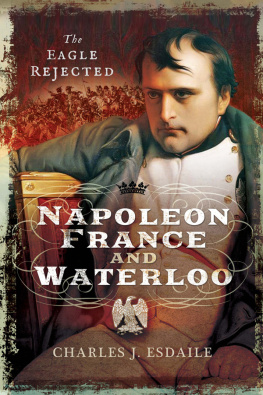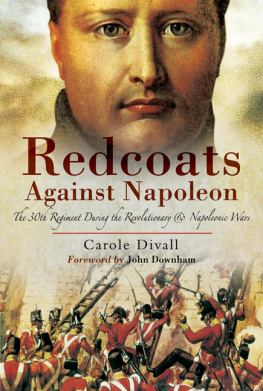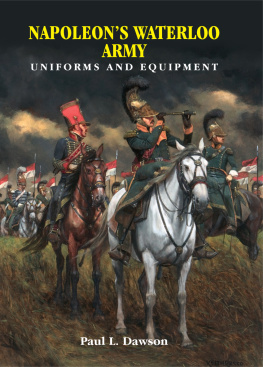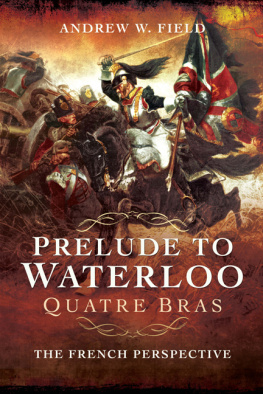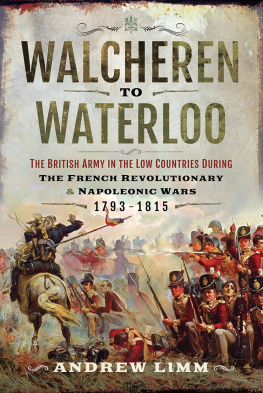
Napoleon, France and Waterloo
In loving memory of Irene Collins, colleague, friend, mentor and fellow labourer in the Napoleonic vineyard.
Napoleon, France and Waterloo
The Eagle Rejected
Charles J. Esdaile
First published in Great Britain in 2016 by
Pen & Sword Military
an imprint of
Pen & Sword Books Ltd
47 Church Street
Barnsley
South Yorkshire
S70 2AS
Copyright Charles J. Esdaile 2016
ISBN 978 1 47387 082 6
eISBN 978 1 47387 084 0
Mobi ISBN 978 1 47387 083 3
The right of Charles J. Esdaile to be identified as the Author of this Work has been asserted by him in accordance with the Copyright, Designs and Patents Act 1988.
A CIP catalogue record for this book is available from the British Library
All rights reserved. No part of this book may be reproduced or transmitted in any form or by any means, electronic or mechanical including photocopying, recording or by any information storage and retrieval system, without permission from the Publisher in writing.
Pen & Sword Books Ltd incorporates the imprints of Pen & Sword Archaeology, Atlas, Aviation, Battleground, Discovery, Family History, History, Maritime, Military, Naval, Politics, Railways, Select, Transport, True Crime, Fiction, Frontline Books, Leo Cooper, Praetorian Press, Seaforth Publishing and Wharncliffe.
For a complete list of Pen & Sword titles please contact
PEN & SWORD BOOKS LIMITED
47 Church Street, Barnsley, South Yorkshire, S70 2AS, England
E-mail:
Website: www.pen-and-sword.co.uk
List of Illustrations
Napoleon in classic end-of-empire garb. (Napoleon I in 1814 by Jean-Louis-Ernest Meissonier)
1815 saw the revival of guerrilla warfare. (Chouan ambush , variste Carpentier)
During the Hundred Days peasant rebels enjoyed much popular support. (Chouan band , Charles Fortin)
French conscripts march off to glory. (Departure of the Conscripts in 1807 by Louis Lopold Boilly)
The Battle of Leipzig. (The Battle of Leipzig,1813, French Infantry Defend Against a Prussian Assault by Paul-mile Boutigny)
A somber picture replete with images of bleakness and exhaustion. (Napoleon and His Staff, 1814 , by Jean-Louis-Ernest Meissonier)
Marshal Marmont at the defence of Paris, 1814. (La Barrire de Clichy , 1814 , by Horace Vernet)
The myth of 1814 encapsulated. ( Scene from the French Campaign, 1814 , by Horace Vernet)
The Battle of Bayonne. (The Sortie from Bayonne, 1814 , by Thomas Sutherland)
The Emperor Alexander and his staff on the heights of Montmartre. (The Battle of Paris, 1814 , by Gottfried Willewalde)
Alexander I and Frederick William III enter Paris. (Russian army, Paris, 1814 , artist unknown)
The Imperial Guard weeps as it bids farewell to Napoleon. (Adieux de Napolon la Garde impriale by Antoine Montfort)
Cartoon mocking Napoleon. ( The Journey of a Modern Hero to the Island of Elba by George Cruikshank)
Napoleon says goodbye to Elba. (Napoleon Bonaparte leaving Elba, 26 February 1815 , by Joseph Beaume)
The French army rushes to do homage to Napoleon. ( Napoleons Return from Elba by Charles Steuben)
Caricature of Napoleon. (Wahre Abbildung des Eroberers Napoleon Bonaparte, Kaiser der Franzosen. Anno 1815)
The Battle of Thouars. (The Battle of Thouars, 1815 , artist unknown)
The Battle of Rocheservire. (The Battle of Rochesevire, 1815 , artist unknown)
Wellington. (The Duke of Wellington after Sir Thomas Lawrence)
Blcher. (Gebhard Leberecht von Blcher , artist unknown)
Quatre Bras. (The 28th Regiment at Quatre Bras by Lady Butler)
Dutch troops at Waterloo. (Artist unknown)
The Imperial Guard at Waterloo. (Napoleons Last Grand Attack by Ernest Crofts)
The Prussians at Plancenoit. ( The Prussian Attack on Plancenoit by Adolph Northen)
The French army streams away from Waterloo. (Flight of French army from Waterloo , artist unknown)
Napoleon in 1814. (Napoleon at Fontainebleau , workshop of Paul Delaroche)
Fierce fighting in Alsace. (The Siege of Strasbourg, 1815, Fighting at Oberhausbergen , artist unknown)
The siege of Strasbourg. (The Battle for Grimma Gate by Ernst Strassburger)
Preface
T wo hundred years on from the fall of Napoleon, one thing is certain, and that is that the Napoleonic legend is as strong today as it ever was. Although many figures in the academic world are critical, indeed even fiercely critical, within its portals there are still those Mike Broers, Alan Forrest and Stephen Englund who at the very least see Napoleon as a reformist who was genuinely committed to building a new social and political order, and, what is more, a new social and political order that was in many respects wholly admirable. Meanwhile, beyond the ivory tower Napoleon remains a figure who continues to be associated not just with such personal qualities as romance, heroism and adventure, nor even with military genius, but also with freedom, progress, democracy and all the advances of the modern world: for a recent example of such thinking, one has only to turn to Andrew Roberts Napoleon the Great (London, 2014). In brief, then, in many eyes the emperor remains, if not the very epitome of the French Revolution, at the very least its instrument. Of course, just how far such a popular view of Napoleon can be said to exist cannot be measured with any certainty without the benefit of substantial market research, but what is certainly the case is that the past half-century has not shown any let-up in the flood of books and other materials that has kept the legend of Napoleon alive. In 1970, in the feature film, Waterloo , Dino de Laurentis gave us a version of the climactic battle of the Napoleonic Wars that was as emphatic in its presentation of the emperor as a man of 1789 as it was deficient in its history, whilst in 1977 the writer, Vincent Cronin, produced a biography so hagiographic that it might as well have been dictated to him on Saint Helena. In 1993 David Hamilton-Williams published Waterloo: New Perspectives the Great Battle Re-Appraised , this being followed very closely by a second volume entitled The Fall of Napoleon: the Final Betrayal , the general tenor of these two works being to present the emperor as a great champion both of France and of the values of the Revolution who had been brought down only by the unremitting hostility of the ancien rgime (and, more particularly, Britain) and the treason of a variety of trusted subordinates. To quote the peroration of The Fall of Napoleon :
To the people of France he was Napoleon, their emperor, created by their will and unbeaten in war. Betrayed in 1814 by Talleyrands conspiracy aided by Marmont and Augereau and the senators. Betrayed again in 1815 by Fouch, Lafayette, Davout and the members of the chambers. Betrayed by his father-in-law, the emperor Francis But not by the people of France not by the nation.
Nor is Hamilton-Williams isolated in his rhetoric. On the contrary, across the Channel such romanticism is also alive and well. For a good example, one has only to turn to the pages of F.G. Hourtoulles 1814: the Campaign for France the Wounded Eagle (Paris, 2005). Sumptuously illustrated with endless depictions of overwhelming Allied numbers on the one hand and heroic French defenders on the other, not to mention a greatcoated and grim-faced Napoleon, this is essentially a straightforward military narrative whose numerous maps make it extremely easy to follow (in this respect, it is greatly to be preferred to F.L. Petres Napoleon at Bay, 1814 [London, 1913]). Yet the level of analysis is, at best, woeful. Thus, coverage of Napoleons attempted reconstruction of the Grande Arme in the wake of Leipzig is restricted to a brief recapitulation of the measures that he took to bring in fresh recruits with no reference to the extent to which he was successful. Of the response of France to the new leve en masse , then, we hear nothing, Hourtoulle instead falling back on the tired old argument of the stab in the back:
Next page
